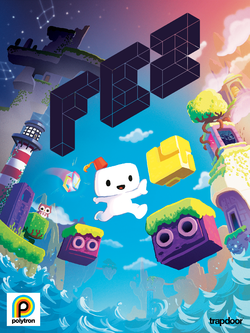Portal:Video games
The Video Games Portal

A video game or computer game is an electronic game that involves interaction with a user interface or input device (such as a joystick, controller, keyboard, or motion sensing device) to generate visual feedback from a display device, most commonly shown in a video format on a television set, computer monitor, flat-panel display or touchscreen on handheld devices, or a virtual reality headset. Most modern video games are audiovisual, with audio complement delivered through speakers or headphones, and sometimes also with other types of sensory feedback (e.g., haptic technology that provides tactile sensations). Some video games also allow microphone and webcam inputs for in-game chatting and livestreaming.
Video games are typically categorized according to their hardware platform, which traditionally includes arcade video games, console games, and computer games (which includes LAN games, online games, and browser games). More recently, the video game industry has expanded onto mobile gaming through mobile devices (such as smartphones and tablet computers), virtual and augmented reality systems, and remote cloud gaming. Video games are also classified into a wide range of genres based on their style of gameplay and target audience. (Full article...)
Featured articles –
Like the previous installment, Sinistar: Unleashed focuses on the destruction of the Sinistar, a large bio-mechanical machine, powered by machines called the Sporg. To achieve this goal, the player has a variety of starships, power-ups and weapons. Unlike its predecessor, the game has full three-dimensional graphics and a wider control scheme. Sinistar: Unleashed features 29 levels, five of which are hidden; each level has a Sinistar.
Sinistar: Unleashed received mixed reception when released. Critics lauded its audacity, as well as the addition of new features into the game. Several journalists felt that GameFX captured all the elements that represented a Sinistar game and stayed true to the franchise by feeling familiar to fans of the original game. However, critics faulted the boss designs and the repetitiveness of the gameplay. (Full article...)
In Islanders, players earn points by strategically placing buildings from their inventory onto a procedurally generated island. Earning points restocks the building inventory, eventually unlocking new types of buildings and the ability to move to a new island and continue the session. The session ends when no more points can be gained because no buildings are available or there is no space to place them. The overall goal of the game is to obtain the highest score possible in a single session.
Islanders was developed over seven months while the members of Grizzly Games were completing degrees in video game design at HTW Berlin. The developers were inspired by a mutual love of city-building games, and chose to embrace simplicity in designing Islanders because of the limitations of working with a small team. Employing procedural generation of new islands enabled them to keep the game's mechanics simple while still providing the player enough variety to make the game engaging for repeat sessions. (Full article...)
Designer Keita Takahashi struggled to pitch the game to Namco's superiors, eventually seeking student aid from the Namco Digital Hollywood Game Laboratory to develop the project for less than US$1 million. As director, Takahashi emphasized concepts of novelty, ease of understanding, and enjoyment.
Katamari Damacy received positive reception, becoming a surprise hit and winning several awards. Its success led to the creation of the greater Katamari franchise, and inspired numerous subsequent games imitating its quirky, colorful charm. Some critics have hailed it as a cult classic and one of the greatest video games of all time, praising its gameplay, replay value, humor, originality, and Shibuya-kei soundtrack. A high-definition remaster of the game, Katamari Damacy Reroll was released by Namco's successor Bandai Namco Entertainment for Windows and Nintendo Switch in December 2018, PlayStation 4 and Xbox One in November 2020, and Google Stadia in September 2021. (Full article...)
Kingdom Hearts II is the third game in the Kingdom Hearts series, and takes place one year after the events of Kingdom Hearts: Chain of Memories. Sora, the protagonist of the first two games, returns to search for his lost friends while battling the sinister Organization XIII, a group of antagonists previously introduced in Chain of Memories. Like previous games, Kingdom Hearts II features a large cast of characters from Disney and Square Enix properties.
Concepts for Kingdom Hearts II began during the end of development of Kingdom Hearts Final Mix, with the game entering full development in 2003 and being announced at Tokyo Game Show 2003. Most of the first game's development team returned, including director Tetsuya Nomura, with the game being developed concurrently with Chain of Memories. In developing Kingdom Hearts II, the development team sought to address user feedback from the first game, give the player more freedom and options in combat and present a deeper and more mature plot. (Full article...)
Did you know... -
- ... that the video game Serious Sam: Tormental was originally inspired by Geometry Wars?
- ... that Rockstar Vienna was the largest video game developer in Austria when it closed in 2006?
- ... that the science-fiction video game The Anacrusis is named after a musical term?
- ... that the urban legend Herobrine was ranked on a Guinness World Records poll of the best video game villains, despite never existing?
- ... that Goodboy Galaxy was the first commercially released video game for the Game Boy Advance in more than 13 years?
- ... that, near the ending of the 2005 interactive storytelling video game Façade, two characters portrayed through AI chatbots ask the player for relationship advice?
- ... that a pink skin for Mercy in the video game Overwatch helped raise more than $12 million for breast cancer research?
- ... that fighting video game Panza Kick Boxing was endorsed by a French kickboxing champion who also supplied technical advice?
- ... that Terra Invicta's development company is a group of former volunteer video game modders that decided to release their own game after the success of their mod?
- ... that Rawson Stovall became the first nationally syndicated video game journalist in the United States when he was only eleven years old?
- ... that the video game Manor Lords was wishlisted more than three million times on Steam after its developer had estimated it would receive around 14,000?
- ... that Through the Darkest of Times was the first video game published in Germany to use swastikas?
Selected biography –
Selected image -

Recent video game-related events
- April 4, 2025 – Tariffs in the second Trump administration
- Multiple companies, including Klarna, StubHub, Nintendo, and Professional Sports Authenticator, pause price-sensitive business actions in the U.S. to evaluate the impact of the recent tariff announcements. (The Wall Street Journal) (IGN) (The Verge)
- January 16, 2025 –
- Nintendo officially reveals the Nintendo Switch 2 video game console, the successor to the Nintendo Switch. (Nintendo)
- September 12, 2024 – 2023–2024 video game industry layoffs
- Microsoft announces that it will lay off 650 Microsoft Gaming employees as part of cuts to its workforce. (Variety)
Topics
Categories
Things you can do
In other Wikimedia projects
The following Wikimedia Foundation sister projects provide more on this subject:
-
Commons
Free media repository -
Wikibooks
Free textbooks and manuals -
Wikidata
Free knowledge base -
Wikinews
Free-content news -
Wikiquote
Collection of quotations -
Wikisource
Free-content library -
Wikiversity
Free learning tools -
Wiktionary
Dictionary and thesaurus














































